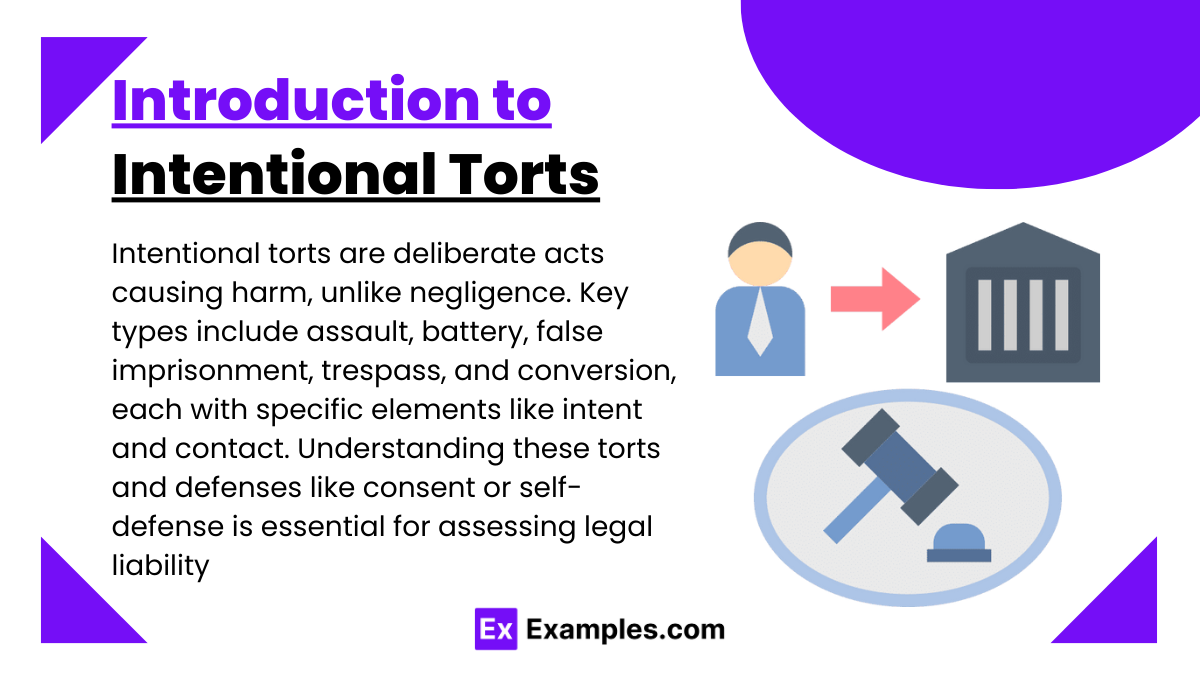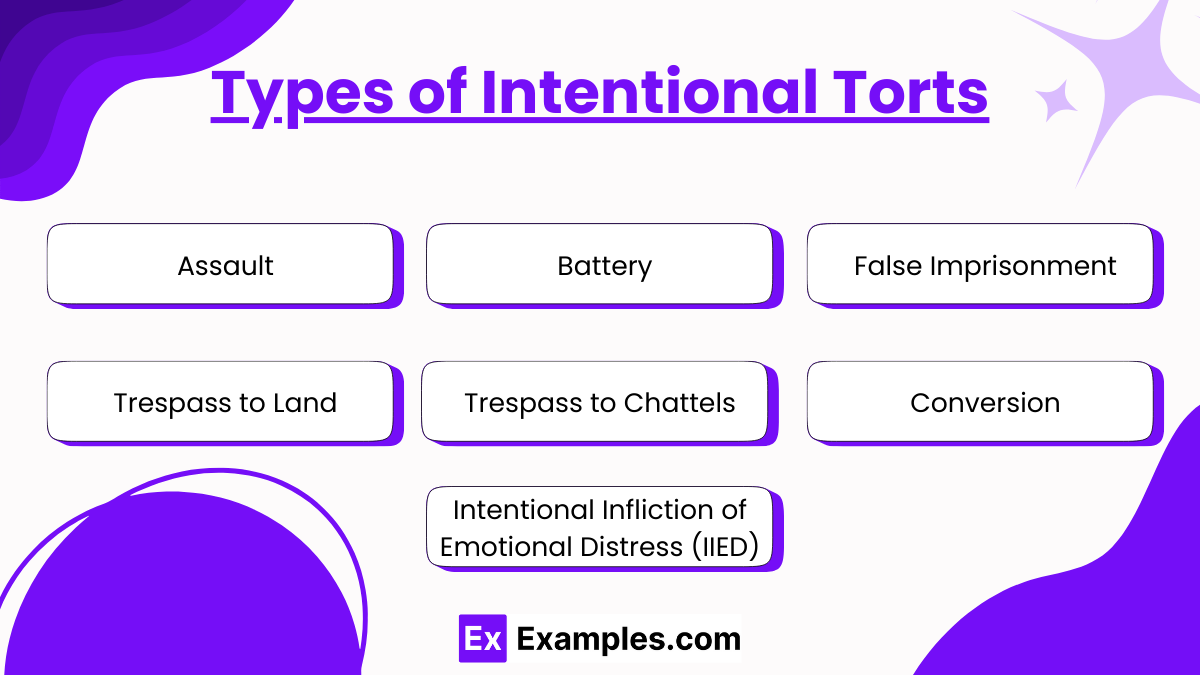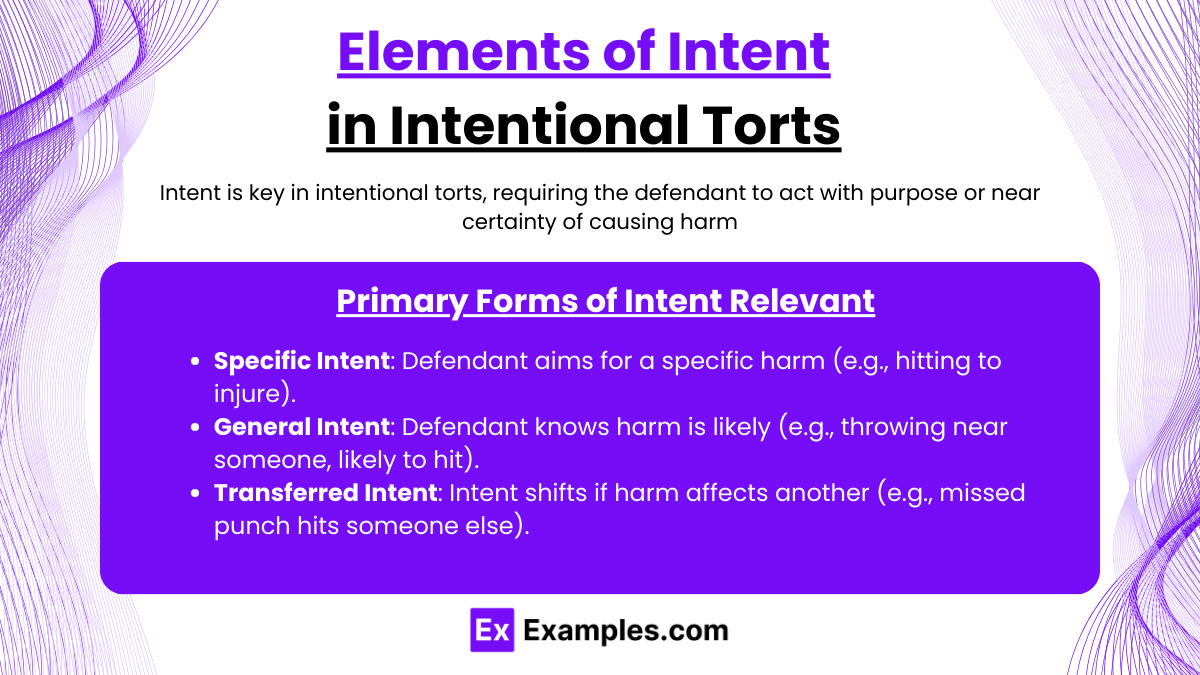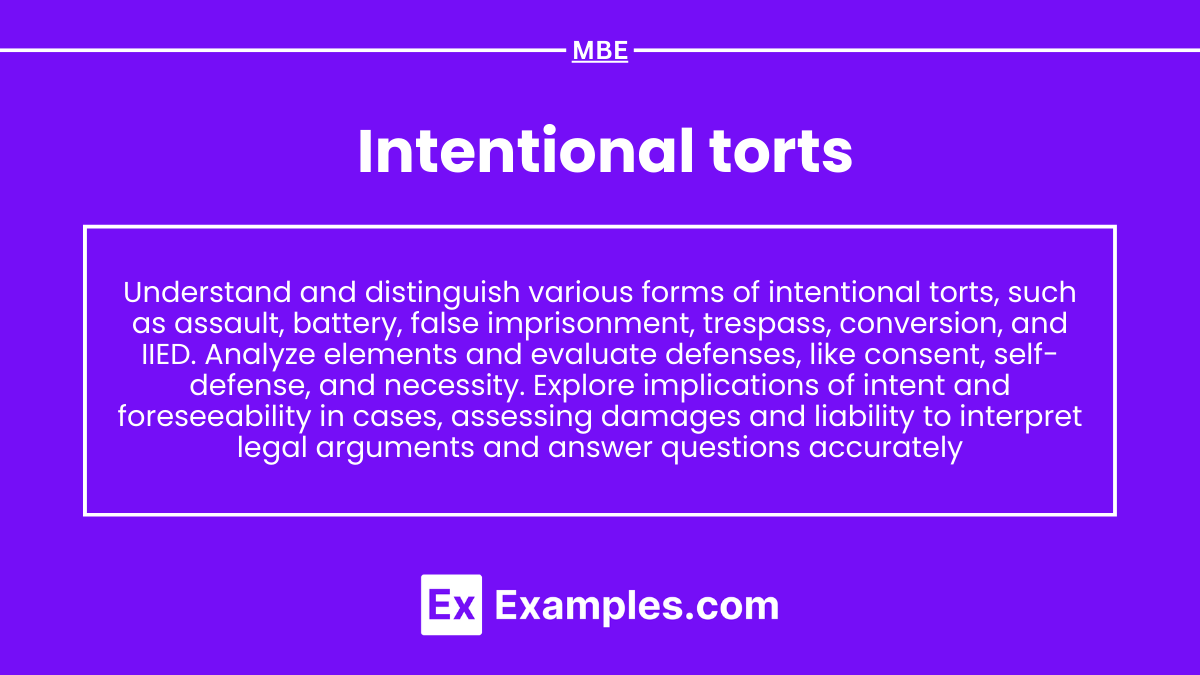Preparing for the MBE Exam requires a thorough understanding of intentional torts, a key area in tort law. Mastery of concepts such as assault, battery, false imprisonment, and intentional infliction of emotional distress is essential. This knowledge underpins the evaluation of legal responsibility, defenses, and damages, critical for a high MBE score.
Learning Objective
In studying “Intentional Torts” for the MBE Exam, you should learn to identify and distinguish between the various forms of intentional torts, including assault, battery, false imprisonment, trespass, conversion, and intentional infliction of emotional distress. Analyze the specific elements that must be proven for each tort and evaluate potential defenses, such as consent, self-defense, and necessity. Examine the implications of intent and foreseeability within intentional tort cases and explore their application in real-world scenarios. Additionally, develop the ability to assess damages and determine liability, applying this knowledge to interpret legal arguments and answer practice questions accurately on the MBE.
Introduction to Intentional Torts

Intentional torts are wrongful acts committed with a deliberate intention to cause harm or with knowledge that harm is likely to result. In contrast to negligence, where harm may arise from carelessness or a lack of foresight, intentional torts require purposeful or knowingly harmful actions directed toward another person or their property. This area of tort law encompasses actions that intrude on personal rights, such as physical safety, freedom, and property security.
Understanding intentional torts involves examining the specific elements that define each tort, such as intent, contact, and confinement. In intentional torts, intent plays a central role; it means the defendant acted with the goal of bringing about a specific outcome or, at a minimum, was substantially certain that the result would occur. This makes intentional torts distinct from other torts that may arise out of accidental or unintended consequences.
In the context of intentional torts cover common categories like assault, battery, false imprisonment, trespass, and conversion. Each has its own elements that must be proven for liability to be established, as well as defenses that may absolve the defendant, such as consent or self-defense. Understanding intentional torts is essential for analyzing liability in scenarios where harm results directly from an individual’s actions, making it a crucial area of study for aspiring attorneys
Types of Intentional Torts

Intentional torts cover a range of wrongful acts that involve direct actions by one individual that cause harm to another or their property. Each type of intentional tort has specific elements that define it, requiring clear intent on the part of the defendant. Understanding these types is crucial for identifying legal liability in scenarios where harm is purposefully inflicted.
1. Assault
Assault occurs when one person’s action causes another person reasonable apprehension of imminent harmful or offensive contact. Unlike battery, assault doesn’t require physical contact—only the threat or attempt to make harmful contact. The critical elements are the intent to create apprehension and the victim’s reasonable belief that the contact is about to occur. For example, raising a fist as if to hit someone can be considered assault if the other person feels an immediate threat.
2. Battery
Battery involves intentional harmful or offensive physical contact with another person without consent. The contact doesn’t have to cause injury; it just needs to be offensive or harmful. The core elements are intent, physical contact, and lack of consent. A classic example of battery is intentionally pushing someone or hitting them.
3. False Imprisonment
False imprisonment is the intentional confinement of a person within a restricted area without legal justification or the person’s consent. The confined person must be aware of the confinement or suffer harm as a result. This tort applies to situations where someone is prevented from leaving a place, such as being locked in a room or restrained without reason. Key elements include intent to confine, actual confinement, and awareness or harm due to the confinement.
4. Trespass to Land
Trespass to land occurs when someone intentionally enters another’s property without permission. It doesn’t matter whether harm was intended or caused—the act of unauthorized entry itself constitutes the tort. Elements include intentional entry and lack of permission. This tort extends to situations where someone places objects on another’s property without consent, as in the case of leaving items on a neighbor’s land.
5. Trespass to Chattels
This tort involves intentionally interfering with another person’s personal property (chattels), causing damage or depriving the owner of its use. Trespass to chattels requires intent, interference, and actual damage or loss of use. Examples include taking or damaging someone’s personal items without permission. The interference must be significant enough to warrant legal action but does not need to be permanent.
6. Conversion
Conversion is a more severe interference with another’s personal property, essentially depriving the owner of its use to the extent that the property is considered “converted” by the defendant. This tort often requires the defendant to pay the full value of the property. Conversion includes situations like taking someone’s property and refusing to return it or destroying it beyond repair.
7. Intentional Infliction of Emotional Distress (IIED)
IIED is a tort that arises when someone intentionally engages in extreme or outrageous conduct that causes severe emotional distress to another person. The behavior must go beyond mere insults or annoyances and result in significant psychological impact. Elements include intent (or recklessness), extreme or outrageous conduct, causation, and severe emotional distress. For example, repeatedly harassing someone in a way that causes mental anguish could qualify as IIED.
Elements of Intent in Intentional Torts

Intent is a fundamental component of intentional torts, distinguishing them from torts based on negligence or recklessness. For an action to qualify as an intentional tort, the defendant must have acted with purpose or substantial certainty that their actions would cause harm. There are three primary forms of intent relevant to intentional torts:
- Specific Intent: The defendant’s goal or purpose is to bring about a specific result or harm. For example, if someone strikes another person intending to injure them, this act has specific intent.
- General Intent: Here, the defendant may not aim to cause a particular harm but knows with substantial certainty that their actions will result in harm. An example is throwing a heavy object near someone, knowing it’s very likely to hit them.
- Transferred Intent: This applies when a defendant intends to harm one person but unintentionally causes harm to another. For instance, if someone throws a punch at one individual but hits another by mistake, the intent to harm transfers to the unintended victim.
In intentional tort cases, establishing intent is crucial, as it shows that the defendant acted with knowledge and purpose, which directly links their actions to the resulting harm.
Defenses to Intentional Torts

Defenses to intentional torts provide legal justifications that can absolve or reduce the defendant’s liability. These defenses recognize that, in some cases, intentional actions may be legally permissible or excusable under certain circumstances.
1. Consent
Consent occurs when the plaintiff voluntarily agrees to the defendant’s actions, either expressly or implicitly. If consent is given, it negates the wrongful nature of the act. For example, in a contact sport, players consent to a certain level of physical contact, which would otherwise be considered battery.
2. Self-Defense
Self-defense allows a person to use reasonable force to protect themselves from imminent harm. The force used must be proportional to the threat; excessive force goes beyond the scope of this defense. For instance, using minimal force to repel an attacker is generally justifiable under self-defense.
3. Defense of Others
Similar to self-defense, defense of others permits a person to use reasonable force to protect someone else from imminent harm. The same principles of proportionality apply, meaning that the defender can only use force necessary to prevent the threat.
4. Defense of Property
This defense allows a person to use limited force to protect their property from intrusion or damage. Deadly force is generally not permitted solely for the defense of property, but reasonable force can be used to remove trespassers or prevent property damage.
5. Necessity
Necessity justifies an intentional act if it prevents a greater harm. There are two types:
- Public Necessity: A complete defense that allows actions taken to protect the public from harm, even if private property is damaged. For instance, destroying property to stop the spread of a fire may be justifiable.
- Private Necessity: A partial defense where a person’s actions prevent harm to themselves or their property. However, the defendant may still be liable for damages caused to the plaintiff’s property (e.g., docking a boat on private property during a storm to avoid harm).
Examples
Example 1
A person intentionally pushes another in a crowded area, causing them to fall and break their arm. This is an example of battery, where harmful physical contact was made intentionally.
Example 2
Someone raises a fist as if to hit a coworker, causing the coworker to fear immediate harm. Even if no contact occurs, this act can be considered assault because it creates a reasonable apprehension of harm.
Example 3
A store employee locks a customer in the store accidentally after closing but refuses to unlock the door upon realizing their mistake. This could be considered false imprisonment, as the person is confined against their will without a lawful reason.
Example 4
A person deliberately throws a rock into their neighbor’s yard, entering their property without permission. This act constitutes trespass to land, as it involves intentional intrusion onto another’s property.
Example 5
Someone takes another person’s cell phone without permission, intending to keep it. This act could be seen as conversion, as it deprives the owner of their property by exercising control over it without consent
Practice Questions
Question 1
Which of the following best describes battery in the context of intentional torts?
A) The intentional creation of fear of imminent harm in another person.
B) The intentional and harmful or offensive physical contact with another person without consent.
C) The intentional confinement of another person within a bounded area.
D) The unauthorized entry onto someone else’s property.
Answer: B
Explanation: Battery involves intentional and harmful or offensive physical contact with another person without their consent. Option A describes assault, C describes false imprisonment, and D describes trespass to land.
Question 2
If a person swings a fist at someone intending to hit them but misses and accidentally strikes someone else, what type of intent applies?
A) General Intent
B) Specific Intent
C) Transferred Intent
D) Reckless Intent
Answer: C
Explanation: Transferred intent applies when the intent to harm one person unintentionally causes harm to another. The intent to harm is transferred to the unintended victim.
Question 3
Which of the following scenarios would most likely constitute false imprisonment?
A) Locking someone in a room as a prank and refusing to let them out.
B) Accidentally bumping into someone and causing them to fall.
C) Warning someone they will be arrested if they do not leave a private property.
D) Entering someone’s property without permission to retrieve a lost item.
Answer: A
Explanation: False imprisonment involves the intentional confinement of a person within a bounded area without lawful justification. Locking someone in a room and refusing to let them out meets these criteria.


